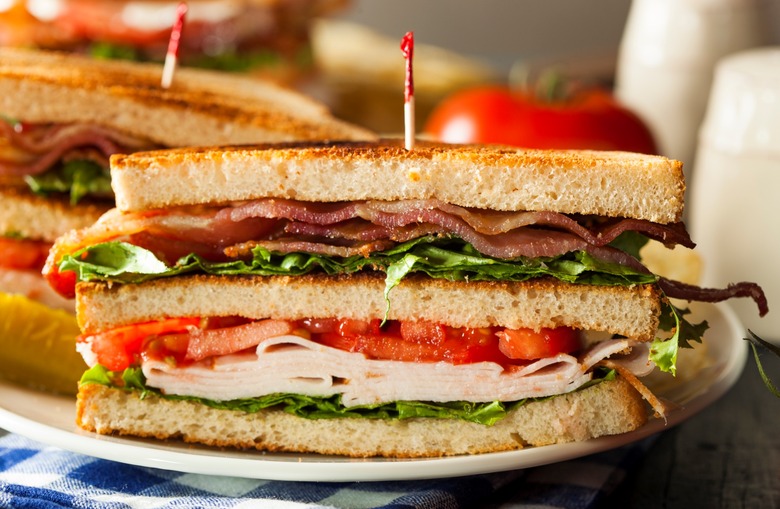No, The 'Club' In 'Club Sandwich' Doesn't Stand For Anything
Does the word "club" in "club sandwich" hold more meaning than we suspected? The internet has recently been atwitter over the revelation that the letters in the word stand for a descriptive phrase: "chicken and lettuce under bacon."
This startling truthiness was brought to light by Twitter user Saul J Henderson (@sjhenderson07), whose insightful musing became a "Twitter moment" that has blown countless credulous minds since May 11 and drew the attention of some media outlets.
No way am I 18 and I've only just found out a club sandwich stands for chicken and lettuce under bacon
— Saul J Henderson (@sjhenderson07) May 11, 2018
We hate to burst anyone's bubble, but the theory, while amusing, doesn't stand up to even casual scrutiny. To start with, there's already a fairly credible origin story for the sandwich's name: It was first popularized at (wait for it) a club. The first reference to the sandwich in print came in 1889, when a "Union Club sandwich" was described as "two toasted slices of bread, with a layer of turkey or chicken and ham between them" in The New York World. (The Union Club of the City of New York is a social club for wealthy men.)
Granted, that explanation is not much fun, so let's evaluate the chicken-and-lettuce-under-bacon theory on its own merits. Even here, we encounter some fundamental problems — not the least of which is that two ingredients usually considered fundamental to the modern iteration of the sandwich are omitted from the supposed acronym. Where's the tomato and mayo, Twitter user @sjhenderson07? Face it: No one wants to eat your dry acronym sandwich.
To those who still support Henderson's theory, we'd suggest you make the sandwich exactly as described, with just chicken and lettuce under bacon, and then let us know how it tastes. We'll wait. And hey! Make sure you put the chicken and lettuce under the bacon, or you might end up with a cbul sandwich or culb sandwich.
We're guessing you won't put the chicken on top under any circumstances, but heaven forfend that you accidentally turn the entire sandwich over, in which case you'd end up with a bulc sandwich. Or perhaps a bluc sandwich?
See, it doesn't matter where you put the "under" in the acronym — because no one orders a sandwich that way. We know you're probably already full from the dry, tomato-less sandwich with no condiments that we just tricked you into eating, but let's try another experiment: Go to your local deli and ask for a sandwich using the word under in your order — and see what kind of look you get from the counterman. Heck, go ahead and add whatever condiments you'd like, since we left out mayo last time, and go easy on the lettuce if that's not your jam. And since your mouth is dry, add some more tomatoes to balance it out. We'll imagine:
Deli Guy: What kinda meat ya want?
You: Chicken and bacon.
Deli Guy: Any condiments?
You: [longingly] Mayo...
Deli Guy: OK, anything else?
You: [realizing you're missing a crucial word] Under...
Deli Guy: [cocks eyebrow skeptically]
You: Light lettuce. Extra tomato.
Congratulations! You finally got the full club sandwich you actually wanted! You also just ordered, according to Henderson's theory, a "cab mullet" sandwich. Sounds delicious!
Was it awkward how we sandwiched the word under into your sandwich order? Well, that should have been a clear tipoff that Henderson's explanation is a classic example of what's called a backronym. As acronyms (words formed from the initial letters of an explanatory phrase, like scuba, NATO, laser, or radar) became more commonplace in speech over the course of the twentieth century, backronyms (explanatory phrases that purport to be the origin of a word based on its letters interpreted as initials) became an increasingly common form of folk etymology (bogus but widely believed explanations of a word's origin). Such constructions typically employ one or two words whose initial letters technically fit the end-word that a folk etymologist wants to form — but in a construction that rings countervernacular upon closer inspection.
(Seriously. Try to put under in your next sandwich order.)
Tempting as it may be to seek out a deeper meaning in words, these cockamamie explanations tend to obscure the more mundane reasons why we call certain things — and certain foods — by the names that we call them. A Big Mac, for instance, was just the biggest sandwich at McDonald's at the time of its introduction.
Actually, that folk etymology, which we just invented out of whole cloth, is also false. The Big Mac struggled under two other names — the Aristocrat (which consumers found understandably off-putting) and the Blue Ribbon Burger (which, we imagine, consumers simply found boring) — before being rebranded as the Big Mac by a 21-year-old advertising secretary in McDonald's Chicagoland headquarters in 1968 to imitate a similarly monstrous burger offered by the now almost forgotten Big Boy restaurant chain.
Let this be a lesson: Don't believe everything you read on Twitter — or anywhere on the internet, for crying out loud. Some people are naive or ignorant, and some are straight-up lying to you for no reason. To learn more about how businesses like McDonald's actually develop and name new sandwiches and other products, take a look at these 12 things you didn't know about McDonald's.
